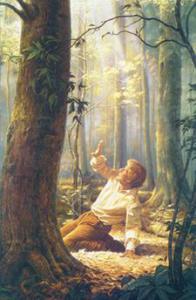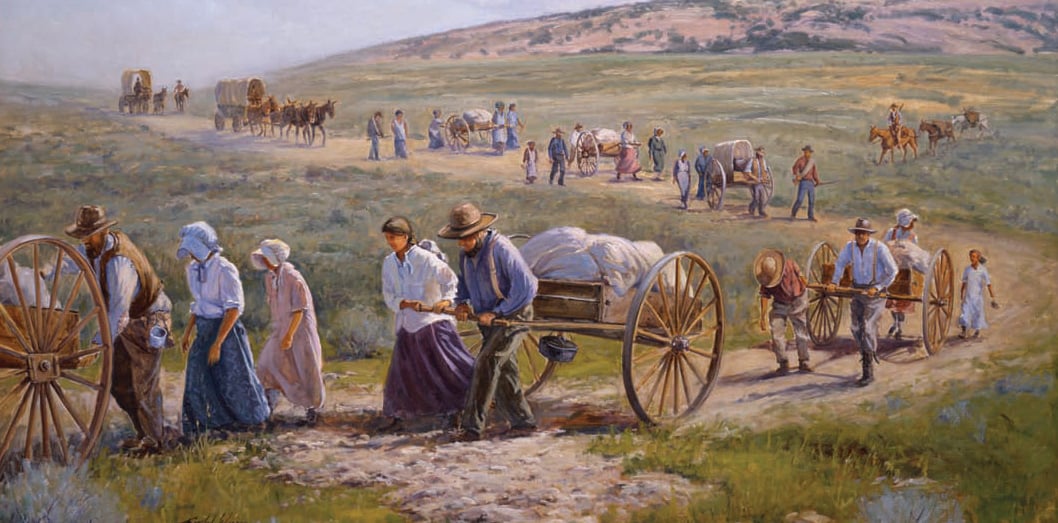Turning and turning in the widening gyre
The falcon cannot hear the falconer;
Things fall apart; the centre cannot hold;
Mere anarchy is loosed upon the world,
The blood-dimmed tide is loosed, and everywhere
The ceremony of innocence is drowned;
The best lack all conviction, while the worst
Are full of passionate intensity.
— “The Second Coming”, William Butler Yeats
Although we didn’t call it by the same name, unverified person gnosis (UPG) is a concept that I have been familiar with since I was a child. I was raised Mormon and we called it “personal revelation”.

The Mormon foundation myth is the story of a young 14-year old boy who went into the woods to pray and to ask God which of all the churches was true. According to the story, God appeared to Joseph Smith and told him that none of the churches in existence at the time were true. In this sense, the Mormon church is built on Joseph Smith’s UPG. Even more than that, the image of the young Joseph Smith praying in the “Sacred Grove” is an archetype* of the contemporary Mormon experience. Every Mormon child and every convert is taught that they can ask God any question and expect to receive an answer (of some kind). Mormons call this “personal revelation”, but it is just another name for UPG. From this foundation myth, I took away the idea that every person’s relationship with the divine was ultimately a personal one, and not mediated by community.
However, running against tradition of individual personal revelation in Mormonism, there is a strong communitarian tradition. The archetype* of Joseph Smith praying in the woods is not the only archetype* of Mormon experience.

Another archetype* is the Mormon pioneers journeying west in search of Zion and then building it together in the Salt Lake Valley. It is a profoundly communal symbol, in contrast to the individualistic symbol of Joseph Smith’s “First Vision”. It is also an authoritarian symbol, as the Mormons were following their leader, Brigham Young (Joseph Smith’s successor), westward. These communal and authoritarian values sometimes come into conflict the individualistic values of Mormonism. While the individualistic principle holds that anyone can receive revelation for themselves, the authoritarian principle dictates that members of the Mormon church must follow the revelation received by those of higher authority than them. Mormons call this “stewardship”. Thus, children are expected to follow their parents, wives their husbands, men their ecclesiastical leaders, and the whole church follows the Mormon prophet. This is how Mormonism mitigates the potentially destructive effects of personal gnosis on community.
For some reason, the pioneer archetype never really resonated with me. I didn’t connect with the stories of the suffering of the pioneers on their western trek or their struggles to carve out home in the desert. Perhaps it was because I was not a descendant of those pioneers (like my wife is); my parents converted when I was young and I never lived in the Mormon corridor. It was much the more individualistic symbol of the solitary prophet in the woods that spoke to me. So perhaps it is not that surprising that I eventually left the Mormon church when my personal gnosis prompted me to break with my community, like the young Joseph Smith did.
When I left Mormonism, I took another individualist as my guide: Emerson. Emerson famously wrote in his essay “Nature”:
“Why should not we also enjoy an original relation to the universe? Why should not we have a poetry and philosophy of insight and not of tradition, and a religion by revelation to us, and not the history of theirs? […] Let us demand our own works and laws and worship.”
Emerson’s essay “Self-Reliance” became for me at that time a kind of personal manifesto. He writes:
“Whenever a mind […] receives a divine wisdom, old things pass away, — means, teachers, texts, temples fall; […] history is an impertinence and an injury, if it be any thing more than a cheerful apologue or parable of my being and becoming.”
“[W]hen you have life in yourself, it is not by any known or accustomed way; you shall not discern the foot-prints of any other; you shall not see the face of man; you shall not hear any name;– the way, the thought, the good, shall be wholly strange and new. It shall exclude example and experience. You take the way from man, not to man.”
Clearly, Emerson had no qualms about UPG. It’s no coincidence, I think, that he found himself unable to live in communion with his own religious community (Unitarianism). Like Emerson, at the time, I saw all institutionalized religion as antithetical to personal spirituality.
When I discovered Neo-Paganism, it was not through any group, or even through any human contact for that matter. I discovered Neo-Paganism in the library. Ronald Hutton, Margot Adler, Starhawk, and Vivianne Crowley were my guides. As an eclectic Neo-Pagan, I “poached the stacks” for inspiration and built a personal practice with UPG as my only guide. It was not for several years until I eventually sought out real live Pagans. And even then, I felt no real community with them, probably because my sense of what Paganism had developed in relative isolation. Most of my interaction with other Pagans today remains virtual. And from the results of every survey of Pagans I have read, as well as anecdotal evidence, it seems that I am typical of most Pagans in all of these ways.
But I do feel a longing for Pagan community, especially a ritual community, or the feeling communitas that can be created in group ritual Solitary ritual has unique benefits, but it is no substitute for group ritual. But how does an individual who places such a high value on personal gnosis find community? And how does a movement full of such individuals, like Neo-Paganism, create and sustain community?
My ambiguous attitude toward community was revealed unintentionally when I wrote my post describing the three centers of Paganism: (1) nature, (2) Self, (3) deities (taken from Graham Harvey’s book, What Pagans Believe, which describes Pagan practices in three sections: “Celebrating Nature”, “Working Magic”, and “Honoring Deities”). I later added folk- or community-centered Paganism at the suggestion of one of the commenters to my post, M. Jay Lee, but the fact that I left it out in the first place is indicative of the fact that I did not know where community fit into my view of Paganism. Even now, I am not quite convinced that the fourth “center” belongs in the schema.
This tension between individual experience and religious community was highlighted for me recently in a post by Sam Webster about UPG, which Webster describes as “an ugly, misguided”, as well as a “dismissive and insulting”, term. Webster correctly, I think, points out that religious traditions and texts are themselves based on UPG:
“All religiosity is derived from someone having an experience. Sometimes in company, but most times alone, someone had an experience and then shared it with others. […] Experience is the center of all spiritual and religious life. Text is at best derivative. By creating and using such a term as UPG, “Unsubstantiated Personal Gnosis” we privilege text over experience. […] Even more damagingly, by framing someone’s experience as a UPG we dissociate ourselves from the primary data of spirituality. We can then bracket and set aside the immediate real, and go back to our books.”
And I agree with Webster that, at the very least, the term “UPG” is problematic because it implies that personal gnosis needs to be “verified” (i.e., legitimated) by the community. Like Webster, I tend to balk at any suggestion that I should sacrifice my personal judgment to the needs of the group.
I remember first encountering the term “UPG” and feeling, like Webster, a certain distaste for the term, and thinking that it really had no place in Paganism. Of course, when I first encountered the term, it was not in a strictly Pagan context, but in a Heathen one. In fact, it was not until the last few years that I began to see the term used by Pagans. The term “UPG” has an important place in Heathenry, because Heathenry is much more community-centered the contemporary Paganism. As Galina Krasskova writes in her Master’s thesis:
“[Heathen] Religious rituals are primarily viewed as a means of building community. There is little understanding or desire in the majority of the community for rituals that create a palpable sense of the sacred external to that community building. In fact, it seems likely that the reconstructed rituals of blót and symbel were primarily viewed at first as merely active extensions of the lore, a means of creating a community Weltanschauung. Certainly there is a marked ambivalence in Heathenry toward the Gods.”
Krasskova goes so far as to say that Heathen ritual is structured “to keep the sacred at bay”. Why? Because it is a threat to community:
“Heathen ritual is structured precisely to avoid any emotional or physical expressiveness that may transcend the accustomed social order. Rites like symbel and blót are viewed as necessary buffers between the orderly, civilized, mundane world and the potentially dangerous, inhuman, and unpredictable world of the Gods and spirits. It is this very unpredictability, inherent in personal gnosis that seems so threatening to the modern community, which uses its rites and rituals to keep that threatened instability (and by extension their own emotional messiness) at bay.”
In recent years, however, Heathenry has had an increasing influence on Paganism. (This is due, it seems, largely to the influence of Pagans like Diana Paxson, Raven Kaldera, and Galina Krasskova who have been influenced by Heathenry.) In contrast to Heathenry, however, Paganism generally places a priority on personal experience. Tradition is devalued whenever it is seen as an impediment to personal authority and direct experience of the divine. (See Christine Hoff Kraemer, Seeking the Mystery, esp. Ch. 3.) In spite of this, the term “UPG” has been carried over from its community-centered religious context, and it seems like we Pagans don’t know quite what to do with it.
But I would argue that the term “UPG” does have a place in Paganism too, precisely because it highlights the problematic nature of the emphasis on personal experience in Paganism. This was brought out in a comment by “Scott” to Webster’s post:
“My concern is that you’re problematizing it without addressing the real question that the term (and others like it) were meant to address: in a world where we *do* take religious experience seriously, how do we distinguish between forms of experience which can be generalized, and those which, for whatever reason, cannot? […] UPG is a term for an experience for which we *do not* have verification through replication, either by text *or* by independent experiences […] If it’s an actual contact from a Deity, it might be intended solely as a direction for that practitioner, or it might be more widely applicable as (for example) a general preference for a particular offering for that Deity. Bracketing that experience with the term ‘UPG’ until it is independently verified is a method by which our community negotiates our understanding of this material.” (emphasis added)
Scott’s comment reveals how the term “UPG” is used to mediate between personal gnosis and community.
What I think Webster fails to appreciate is that personal gnosis is always a potential threat to community. Personal gnosis must be “routinized” to some extent, to borrow Max Weber’s terminology, if community is to persist. Certainly, in the short term, we can always have small scale community based on personal relationships without doing violence to personal gnosis. But how do we ensure that the community survives the inevitable conflicts that arise between people? And how do we ensure that our community can survive more than a single generation?
The problem of personal gnosis is highlighted by the dynamics of new religious movements. New religious movements are often founded on the personal gnosis of a charismatic individual. When that founder dies, the personal gnosis of competing successors threatens to tear the community apart. Those movements that survive the death of the leader are those that create institutions to “routinize” personal gnosis. Sociologist Max Weber calls this the “routinization of charisma”. This was what happened to Mormonism when Joseph Smith died and Brigham Young succeeded him. A recent post on the Peculiar People blog here at Patheos documents one aspect of a shift in Mormonism from a “Protestant” preference for decentralized personal religion (symbolized by Joseph Smith) to a Catholic-like concern for centralizing authority in church institutions (symbolized by Brigham Young). Paganism, in contrast, appears to have gone in the opposite direction, toward greater decentralization and personalization. (See Fritz Muntean’s “The Protestanization of Paganism”.)
But it is not just in the succession scenario that personal gnosis must be “routinized”. Personal gnosis is always potentially threatening to community. This can readily be seen in contemporary Paganism, where the resistance to routinization is high and the feeling of community is weak. Barbara Jane Davy observes: “The individualism of solitaries presents a challenge or resistance to the routinization or institutionalization of Paganism.” (Introduction to Pagan Studies, 2007). In order for a community like Paganism to survive, it must find a way to integrate personal gnosis with the communal identity.
Different religions use various mechanisms for “routinizing” the charisma of personal gnosis. Orthodoxy and orthopraxy are two common mechanisms for doing so. Christians often employ creeds, which function as limits on personal gnosis and boundary markers of community. Non-credal forms of Christianity rely on the text of the Bible to perform the same function in a somewhat more fluid way. Mormons, as mentioned above, use the principle of concentric “stewardships” as a limit on personal revelation. And Quakers have an institution called “clearness committees” which can help individuals to integrate personal gnosis with community values.
Pagan groups employ similar mechanisms. Contrary to the common statement that Pagans have no orthodoxy, individual Pagans groups do have creeds of a sort. It’s true that most attempts to create a pan-Pagan creed have failed miserably. (Consider the short-lived 1974 Council of American Witches or the more recent attempt to revive the Council in 2011.) But the UK Pagan Federation does have its Three Principles. The Aquarian Tabernacle Church, Church of All Worlds, and the New Reformed Druids of North America have all endorsed the same statement of beliefs at one time. The Covenant of Unitarian Universalist Pagans (CUUPS) attempts to accomplish this through the incorporation of Paganism into the structure of a larger religious organization, the UUA. And contrary to the myth that one can believe anything and still be a UU, Unitarian Universalists do have their Seven Principles which act as a limit on what is tolerable even to Unitarians. (Imagine a Neo-Nazi in UU congregation!)
Similarly, while there is no orthopraxy common to all of contemporary Paganism, various Pagan groups do have their own orthopraxy. The Traditional Wiccas have their liturgies. The ADF has its Core Order of Ritual. Teo Bishop created the Solitary Druid Fellowship liturgies precisely to help create community among solitaries. The various reconstructionist Pagan traditions are developing their own orthopraxies. And there is even a kind of generic Neo-Wiccan ritual structure (circle, calling the quarters, invoking god and goddess) which is common to most pan-Pagan gatherings which coalesced over the years through a homogenizing process which Barbara Jane Davy calls “mimetic isomorphism“. These are all strategies for dealing with the potentially destructive effects of personal gnosis on community.
And the use of the term “UPG” by Heathens and by reconstructionist Pagans to “bracket” personal gnosis is yet another mechanism for mitigating the centrifugal force of personal gnosis. In spite of my predilection for religious individualism and the implied judgment on the “U” in “UPG”, I don’t think this mechanism is any more or less legitimate than the others mentioned above.
The more I think about this issue, the more my either-or attitude toward religious community seems myopic. Does institutional religion have to be the death of personal vision? Does personal gnosis have to undermine religious community? Might not the centrifugal force of personal gnosis and the centripital force of routinization hold each other in a creative tension? The use of the term “UPG” as a linguistic device is, I think, an attempt to do this. We can argue about its effectiveness, but I think we should agree that some mechanism is needed in order to achieve this balance.
* I’m using the term “archetype” here in the colloquial sense of an original pattern or model or prototype, not in the Jungian sense.











